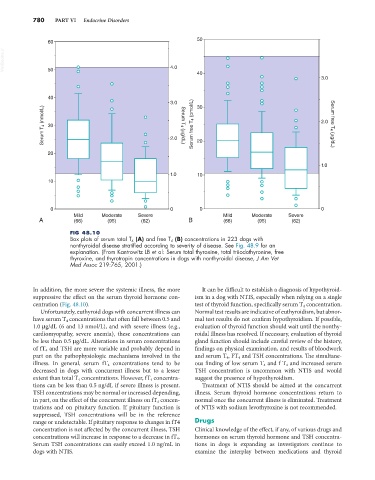Page 808 - Small Animal Internal Medicine, 6th Edition
P. 808
780 PART VI Endocrine Disorders
60 50
VetBooks.ir
4.0
50
40
3.0
40
3.0 30
Serum T 4 (nmol/L) 30 2.0 Serum T 4 (µg/dL) Serum free T 4 (pmol/L) 2.0 Serum free T 4 (µg/dL)
20 20
1.0
1.0 10
10
0 0 0 0
Mild Moderate Severe Mild Moderate Severe
A (66) (95) (62) B (66) (95) (62)
FIG 48.10
Box plots of serum total T 4 (A) and free T 4 (B) concentrations in 223 dogs with
nonthyroidal disease stratified according to severity of disease. See Fig. 48.9 for an
explanation. (From Kantrowitz LB et al: Serum total thyroxine, total triiodothyronine, free
thyroxine, and thyrotropin concentrations in dogs with nonthyroidal disease, J Am Vet
Med Assoc 219:765, 2001.)
In addition, the more severe the systemic illness, the more It can be difficult to establish a diagnosis of hypothyroid-
suppressive the effect on the serum thyroid hormone con- ism in a dog with NTIS, especially when relying on a single
centration (Fig. 48.10). test of thyroid function, specifically serum T 4 concentration.
Unfortunately, euthyroid dogs with concurrent illness can Normal test results are indicative of euthyroidism, but abnor-
have serum T 4 concentrations that often fall between 0.5 and mal test results do not confirm hypothyroidism. If possible,
1.0 µg/dL (6 and 13 nmol/L), and with severe illness (e.g., evaluation of thyroid function should wait until the nonthy-
cardiomyopathy, severe anemia), these concentrations can roidal illness has resolved. If necessary, evaluation of thyroid
be less than 0.5 µg/dL. Alterations in serum concentrations gland function should include careful review of the history,
of fT 4 and TSH are more variable and probably depend in findings on physical examination, and results of bloodwork
part on the pathophysiologic mechanisms involved in the and serum T 4 , FT 4 and TSH concentrations. The simultane-
illness. In general, serum fT 4 concentrations tend to be ous finding of low serum T 4 and f T 4 and increased serum
decreased in dogs with concurrent illness but to a lesser TSH concentration is uncommon with NTIS and would
extent than total T 4 concentrations. However, fT 4 concentra- suggest the presence of hypothyroidism.
tions can be less than 0.5 ng/dL if severe illness is present. Treatment of NTIS should be aimed at the concurrent
TSH concentrations may be normal or increased depending, illness. Serum thyroid hormone concentrations return to
in part, on the effect of the concurrent illness on fT 4 concen- normal once the concurrent illness is eliminated. Treatment
trations and on pituitary function. If pituitary function is of NTIS with sodium levothyroxine is not recommended.
suppressed, TSH concentrations will be in the reference
range or undetectable. If pituitary response to changes in fT4 Drugs
concentration is not affected by the concurrent illness, TSH Clinical knowledge of the effect, if any, of various drugs and
concentrations will increase in response to a decrease in fT 4 . hormones on serum thyroid hormone and TSH concentra-
Serum TSH concentrations can easily exceed 1.0 ng/mL in tions in dogs is expanding as investigators continue to
dogs with NTIS. examine the interplay between medications and thyroid

